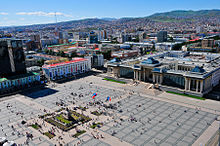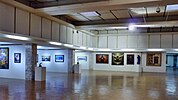


Ulaanbaatar(Mongolian: Улаанбаатар), formerly known asCullen(Mongolian: Хүрээ küriye, meaning "red hero"), yesMongoliaThe capital of Mongolia is also the largest city in Mongolia. Ulaanbaatar is located in the middle of the Mongolian Plateau, with a population of approximately 1.31 million (April 2014) and an area of 4704 square kilometers. It is Mongolia's largest city and political, economic, transportation, cultural, technological, and industrial center.
learn
According to statistics in 2014, a total of 505,686 people visited Mongolia, of which 392,844 were tourists. Most tourists to Mongolia pass through Ulaanbaatar. Among the tourists, there were 239,850 from the Asia-Pacific region, 147,520 from Europe, 3,638 from North America, 1,048 from the Middle East, and 786 from Africa.
history
people
Today Ulaanbaatar is a vibrant city with a population of more than one million. In this city, nomadic traditions and modern society coexist, as can be seen from her skyline dotted with yurts and skyscrapers.
culture
climate
Because Mongolia does not rely on the sea on all sides, it has a temperate continental climate with large temperature differences, short and dry summers, and long and severe winters. The average winter temperature in Ulaanbaatar: -15°C to -30°C; the average summer temperature: 10°C to 26.7°C. A heating system is needed for a total of 180 days to avoid the cold.
arrival
Aviation 
West Ulaanbaatar hasChinggis Khaan International Airport. It is about 18 kilometers from Ulaanbaatar city center to the airport. Currently, Mongolian Airlines, Hunnu Airlines, Air China, Isnis Airlines and other airlines fly to and from cities in various countries.
Railroad 
Tourists can boardSiberian RailwayGo to Ulaanbaatar.
Private car
Bus 
Passenger ship
As Ulaanbaatar is an inland city, it cannot be reached by passenger ships.
transportation
go sightseeing
 |  |  | |
| National Opera | Opera seasonal programs | Drama Theater | National Gallery |
- Bogdo Khan Palace。IntroductionBuilt in 1893-1903, it is located at the foot of Bogdokhan Mountain. Formerly the summer residence of the Mongolian religious leader Bogdo Khan Zhebuzundamba (1869-1924), it is one of the most important historical monuments in Mongolia. There are 7 monasteries in the palace, and the main entrance was built between 1912-1919. No nail was used in the whole building, only 108 mortises were used. There is also a small two-story European-style building, which is Bogdokhan’s winter residence. The palace displays exhibits of Mongolian traditional culture and religion from the 17th to the 20th centuries.
- Mongolian History Museum。IntroductionThe Mongolian History Museum was built in 1924. The museum displays the historical changes of the Mongolian Plateau from the original people of Eurasia to the present in seven exhibition halls. A total of 46,000 archaeological, historical and ethnographic exhibits are displayed in the museum.
- Georgi Lamasery Museum。IntroductionThere are 108 sets of Buddhist Qiangmu dance masks and other religious items in the Qiaoji Lamasery.
- Zanabazar Art Museum。IntroductionThe museum is named after Mongolia's first World Bogda Khenpo, famous scholar, philosopher, sculptor, and painter Zanabazar (1635-1723). The museum displays other artworks reflecting life at the time, unparalleled Buddha statues, and hundreds of artworks by Mongolian painters.
- Mongolian Museum of Contemporary Art。IntroductionThe museum raises the public's awareness of contemporary art through exhibitions, collections, and researches on contemporary Mongolian art. It collects modern and contemporary works of Mongolia from the beginning of the 20th century to the present, including paintings, oil paintings, sculptures, handicrafts, printing and other works. The museum has opened a permanent exhibition hall for important artists' works, and extensively conducts non-governmental exchanges and cooperation in contemporary art at home and abroad. Open to the public all year round. With the support of the National Foundation, the collection is increased every year. Every piece of art in the collection has a strong Eastern and Western style. The social influence and academic value of the Mongolian Museum of Contemporary Art has been widely recognized and affirmed.
Activity
learn
jobs
Shopping
Dining
low
medium
luxury
Nightlife
stay
low
medium
luxury
Safety
Medical treatment
Communication
service
Next stop
| Route through Ulaanbaatar |
| Irkutsk ← Darhan ← | North | → Sainshanda → Beijing |
